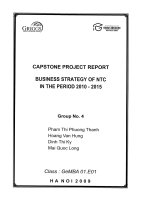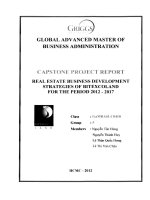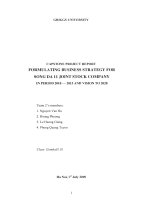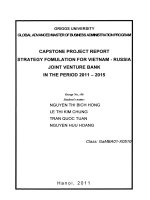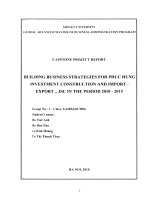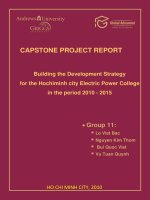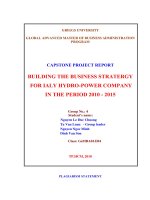Building the business stratergy for ialy hydro-power company in the period 2010 - 2015
Bạn đang xem bản rút gọn của tài liệu. Xem và tải ngay bản đầy đủ của tài liệu tại đây (3.52 MB, 169 trang )
GRIGGS UNIVERSITY
GLOBAL ADVANCED MASTER OF BUSINESS ADMINISTRATION
PROGRAM
CAPSTONE PROJECT REPORT
BUILDING THE BUSINESS STRATERGY
FOR IALY HYDRO-POWER COMPANY
IN THE PERIOD 2010 - 2015
Group No.: 4
Student’s name:
Nguyen Le Duc Chuong
Ta Van Luan - Group leader
Nguyen Ngoc Minh
Dinh Van Son
Class: GeMBA01.E04
TP.HCM, 2010
PLAGIARISM STATEMENT
-1-
In order to successfully complete the assignment of Masters of International
Business Administration, our group have studied different sources of materials such
as textbook, newspapers, magazines and Internet, etc. Besides we have managed to
collect data of Ialy Hydro-power Company. With those sources, we have spent time
and effort summarizing data, analyzing, evaluating and developing this
comprehensive research.
We hereby certify that this dissertation is original and in truth, our own. All
provided information and data we have collected and analyzed are accurate.
Strategies and solutions which are presented here are results of examination of
methodology, and current business situation of Ialy Hydro Power Company as well
as external service market by members of our group. /.
Students
Group 4 – Class GeMBA01.E04
ACKNOWLEGEMENTS
-2-
After more than one year following course Masters of International Business
Administration – Griggs University, we have been provided with valuable
knowledge from our enthusiastic teachers, who have continuously guilded us to
complete this MBA course. Therefore, we take this chance to express our sincere
thank to all your monumental support.
In particular, we want to thank the Steering Committee of Ialy Hydro Power
Company; departments and workshops here for substantial help and favourable
conditions they have created for us. We wish all Company’s staff health and
happiness; and obviously success will come to Ialy Hydro Power Company so
Company’s position will be strengthened more and more in Vietnam Electricity
Industry.
Last but not least, we would not have the opportunity to follow this MBA course
and attempt to achieve our dream without Vietnam Electricity (EVN) support,
which we highly appreciate and wish to send our special thank to them.
We are grateful to all your time and support which should deserve beyond a mere
thank.
Students
Group 4 - Class GeMBA01.E04
TABLE OF CONTENTS
-3-
INTRODUCTION 11
1. Rationale 11
2. Objectives and scope of the capstone 12
2.1. Objectives 12
2.2. Scope of the capstone 12
3. Methods of research 12
3.1. Method of collecting data 12
3.2. Method of research 12
4. Scientific significance and merit of this capstone 13
4.1. Scientific significance of this capstone 13
4.2. Merit of this capstone 13
5. Organization of the capstone 13
CHAPTER 1: REVIEW OF LITERATURE 15
1.1. DEFINITION AND CLASSIFICATION OF BUSINESS STRATEGY 15
1.1.1. Definition of business strategy 15
1.1.2. Classification of business strategy 15
1.1.3. Business-level strategy 16
1.2. BUSINESS STRATEGY PLANNING PROCESS 17
1.2.1. Identification of mission and core objectives 18
1.2.2. Analysis of external environment 18
1.2.3. Analysis of internal environment 21
1.2.4. The formation of business strategy 23
1.2.5. Methods for the implementation of business strategy 23
1.2.6. Evaluating the efficiency of established business strategy 24
-4-
1.3. SOME MATRIX CAN BE PURSUED FOR BUSINESS STRATEGY
PLANNING 24
1.3.1. External Factor Evaluation (EFE) Matrix 24
1.3.2. Internal factor evaluation (IFE) matrix 25
1.3.3. Competitive profile matrix 26
1.3.4. SWOT Matrix 27
1.3.5. Internal – External matrix (IE) 29
1.3.6. QSPM matrix (Quantitative strategic planning matrix) 30
1.3.7. Experience in planning business strategy for enterprises. 32
CHAPTER 2: ANALYSIS OF CURRENT SITUATION OF IALY HYDRO
POWER COMPANY 34
2.1. INTRODUCTION OF IALY HYDRO POWER COMPANY 34
2.1.1. History of establishment and development 34
2.1.2. Company’s current organizational structure: 38
2.1.3. Fields of business of the Company 42
2.2. EXTERNAL ENVIRONMENT ANALYSIS 43
2.2.1. Macro-environment 43
2.2.2. Micro-environment 49
2.3. INTERNAL ENVIRONMENT ANALYSIS 59
2.3.1. Analysis of power production and business period 2000 – 2009 59
2.3.2. Analysis of cost for production and business 64
2.3.3. Analysis of production business of services period 2007 – 2009 66
2.3.4. Company’s available resources 69
2.3.5. Production capacity of the Company 70
2.3.6. Company’s financial status 70
-5-
2.3.7. Quality management 70
2.3.8. Company’s culture 71
2.4. ANALYSIS OF STRATEGIC ISSUES AND COMPANY’S MANAGEMENT
PERIOD 2000-2009 72
2.4.1. Strategic objectives period 2000-2009 72
2.4.2. Analysis of strategic issues and management of Company 72
2.5. OBSTACLES OF CONSTRUCTING AND IMPLEMENTING THE
COMPANY’S STRATIGIC GOAL 77
2.6. SUMMARIZE EXISTING PROBLEMS AND ANALYZE THE CAUSES 79
CHAPTER 3: ESTABLISHMENT OF BUSINESS STRATEGY FOR IALY
HYDROPOWER COMPANY IN THE PERIOD 2010 – 2015 81
3.1. OBJECTIVES OF BUSINESS 81
3.2. VISION 81
3.3. MISSION 81
3.4. SOME MATRIX CAN BE PURSUED IN BUSINESS STRATEGY
PLANNING 82
3.4.1. Internal factor evaluation (IFE) Matrix 82
3.4.2. External factor evaluation (EFE) matrix 83
3.4.3. Competitive profile matrix 85
3.4.4. Internal – External matrix (IE) 86
3.4.5. SWOT Matrix 89
3.5. DEVELOPMENT OF BUSINESS STRATEGY 91
3.6. SELECTION OF BUSINESS STRATEGY 92
3.6.1 . QSPM matrix 93
3.6.2. Priority of business strategy implementation (see Table 3.9) 100
3.6.3. Selection of business strategy 100
-6-
3.7. SOME SOLUTIONS FOR THE IMPLEMENTATION OF SERVICES
BUSINESS STRATEGY FOR IALY HYDRO POWER COMPANY IN THE
PERIOD 2010 - 2015 106
3.7.1. Human resources and organization management 106
3.7.2. Marketing the service business 111
3.8. REVENUE SCHEME OF SERVICES BUSINESS 116
3.8.1. Total investment capital and financial strength 116
3.8.2. Calculation of annual revenue 117
3.9. DEVELOPMENT OF ORGANIZATIONAL STRUCTURE OF REPAIR
SERVICE CENTER 120
3.9.1. Structure (see organization Diagram 3.3): 120
3.9.2. Human resources: 121
3.9.3. Rights and responsibility of Director and Deputy Director of Center 122
3.9.4. Relationship of Center and Company 124
3.9.5. Operation budget 124
3.10. PLANNING TO DO THE STRATEGY 125
3.10.1 . Restructure based on roadmap of enterprise privatization 125
3.10.2. Establishing a repair service center in form of Ialy Hydro Power Company’s
subsidiary 127
3.11. SOME RECOMMENDATIONS 130
3.11.1. Recommendation to Government 130
3.11.2. Recommendation to Vietnam electricity (EVN) 130
3.11.3. Recommendation to Ialy Hydro Power Company 130
CONCLUSION 131
REFERENCE 132
APPENDIX 134
-7-
Appendix 2.1: List of small and medium Hydropower plant in Gia Lai 134
Appendix 2.2: List of small and medium Hydro power plants in Kon Tum 139
Appendix 2.3: List of small & medium Hydropower plants in Quang Nam 147
Appendix 2.4: Performance of external service business for the year 2007 149
Appendix 2.5: Performance of external service business for the year 2008 151
Appendix 2.6: Performance of external service business for the year 2009 153
Appendix 2.7: The accounts of the big repairing construction of 2007 156
Appendix 2.8: The accounts of the big repairing construction for the year 2008 158
Appendix 2.9: The accounts of the big repairing construction of 2009 160
Appendix 3.1: List of devices and equipment for activities of repairing, testing and
correction 163
Ialy Hydro Power Company Office
-8-
LIST OF ABBREVIATIONS
No.
Abbreviation
Word
1
Ialy HPC
Ialy Hydro Power Company
2
PR
Public relations
3
ROA
Return On Assets
4
EVN
Vietnam Electricity
5
WTO
World Trade Organization
6
PMP VI
Power Master Plan VI
7
SRV
Socialist Republic of Vietnam
LIST OF CHARTS, DIAGRAMS AND TABLES IN THIS ASSIGNMENT
1. List of diagrams:
No.
Name of chart
Page
Diagram 1.1
Business strategy planning process
18
Diagram 1.2
The five competitive forces of Michael E.Porter
20
Diagram 2.1
Company’s organizational diagram
39
Diagram 3.1
Compensation structure in Company
108
Diagram 3.2
Organizational structure
109
Diagram 3.3
Organizational diagram
121
2. List of charts
No.
Name of chart
Page
Chart 2.1
Power source structure for the year 2010
50
Chart 2.2
Power source structure for the year 2015
51
Chart 2.3
Schedule and annual power production period 2000 -
61
-9-
2009 (million kWh)
Chart 2.4
Power production period 2000 to 2009 (MW)
62
Chart 2.5
Power output from 2000 to 2009 (million kWh)
62
Chart 2.6
Revenue from service period 2007 - 2009
68
Chart 3.1
Revenue from service business2007 – 2009
105
Chart 3.2
Capital structure
117
Chart 3.3
Market for service in 3 provinces of Western – Highlands
119
3. List of Tables
No.
Name of Table
Page
Table 1.1
External Factor Evaluation (EFE) Matrix
25
Table 1.2
Internal Factor Evaluation (IFE) Matrix
26
Table 1.3
Competitive Profile Matrix
27
Table 1.4
SWOT Matrix
27
Table 1.5
Internal – External (IE) Matrix
29
Table 1.6
Quantitatative strategic planning matrix (QSPM)
31
Table 2.1
Comparison of competitors
55
Table 2.2
Performance of power production period 2000 -2009
59
Table 2.3
Company’s plan of big repair in 2009
63
Table 2.4
Cost for power production period 2007 - 2009
65
Table 2.5
Revenue and labor cost of service business and internal
repair
67
Table 2.6
Inventory cost from 2006 to 2008
76
Table 3.1
Internal Factor Evaluation (IEF) Matrix
83
-10-
Table 3.2
External Factor Evaluation (EFE) Matrix
84
Table 3.3
Competitive Profile Matrix
85
Table 3.4
IE Matrix
87
Table 3.5
QSPM Matrix
95
Table 3.6
Priority of business strategy implementation
100
Table 3.7
Salary for repair staff
104
Table 3.8
Revenue from services business
104
Table 3.9
Investment capital
116
Table 3.10
Scheme of assets depreciation
117
Table 3.11
Summary of market for services of operation and
maintenance
119
Table 3.12
Calculation of revenue and profit
120
Flood Spillway – Ialy Hydro-Power Company
-11-
INTRODUCTION
1. Rationale
Ialy Hydro-Power Company, previously known as Ialy Hydropower Plant was
established on 28/02/2000 with Decision No. 10/2000/QĐ-BCN by Ministry of
Industry (now Ministry of Industry and Trade). In 2007, Ialy Hydropower Plant was
officially renamed Ialy Hydropower Company, which is a dependent accounting
unit of Vietnam Electricity (EVN). Over the past years, the Company has obtained
great achievements in power production and business; substantially contributing to
national grid and developing electricity industry in particular as well as national
industrialization, modernization in general.
However, Government and Vietnam Electricity is now planning to restructure
Electricity industry in line with market economy and economic integration in the
region and the world. It is scheduled that power-generating facilities will be
restructured and reorganized in 2010, including Ialy Hydropower Company.
Because Company is currently a dependent accounting unit of Vietnam Electricity
(EVN), therefore Company own business strategy is not explicit and dependent on
Parent Company’s strategy. All business activities are assigned by Vietnam
Electricity (EVN) in order to ensure electricity production and other technical and
economic characteristics; business efficiency is not appropriately paid attention to.
Therefore, to prepare for the reorganization of power-generating facilities and
coming equitization, Ialy is recommended to develop its own business strategy.
Besides, Company will not be able to succeed in today market economy without an
effective business strategy to improve business performance. A business strategy
thus is considered as an essential and indispensable task of every enterprise during
this transition process. In these contexts, our group has come to an agreement to
select this capstone of:
Building the business strategy for Ialy Hydro Power Company in the period 2010 -
2015.
-12-
2. Objectives and scope of the capstone
2.1. Objectives
The objective of this capstone is analyzing, evaluating the current business situation
of Ialy Hydro Power Company; and factors which influence on Company’s business
development. Then we can find its strengths, weaknesses, opportunities and threats
in order to develop an effective business strategy for Company in the period; and
propose suitable solutions for strategy implementation. We have together selected
the year 2015 because this time is stated in National Electricity Development Plan
period 2006-2015 (Electricity Development Plan VI) which is being implemented;
and the Electricity Development Plan VII is being developed from now to 2020,
considering 2025.
Besides, this capstone also attempt to help Ialy Hydro Power Company to operate more
efficiently after organizational restructuring in today market economy.
2.2. Scope of the capstone
Ialy Hydro Power Company is licensed to do business in different fields. Therefore,
this capstone will made research into business strategy of enterprises in general.
Then, based on those research, we will develop specific business strategy for Ialy in
the period, while strategy of service business will be first consideration.
3. Methods of research
3.1. Method of collecting data
Data used in this paper includes secondary data from internal sources of Ialy Hydro
Power Company, Vietnam Electricity (EVN), Internet information; and primary
data by face-to-face interview with Company’s Steering Committee.
3.2. Method of research
Based on collected data, we have processed data with following methods:
comparison, analysis, summation and statistics. Establishment of strategy selection
matrix is implemented with expert method, which means consulting experts
experienced in service business such as repair and maintenance services; consulting
-13-
and training human resources for new hydropower plants; besides consulting
experts about external service market situation of our country to propose criteria
and evaluation. This method is simple and convenient, but less accurate than site
survey because it is expert’s subjective point of view. However, this method is
popular and sufficient to develop a good business strategy for enterprises.
4. Scientific significance and merit of this capstone
4.1. Scientific significance of this capstone
In the context of market economy today, a business strategy is one of the most
important factors to success or failure of one enterprise. It is essential not only to
private but also state-owned enterprises. Therefore, the top priority of each
enterprise should be building one effective business strategy.
There are different methods which can help to develop a good business strategy for
enterprises. Regarding scientific significance, this capstone summarizes different
sources of methodology and based on those findings to develop a business strategy
which is most concise and practical for Company.
4.2. Merit of this capstone
One general business strategy planning process is employed to develop business
strategy for Ialy Hydro Power Company in the period. In fact, State-owned
companies have not paid much attention to the development of business strategy
since the date of establishment because their annual business targets are always
assigned by higher authority. Therefore, in order to successfully operate during
transition into privatized company in near future, a good and effective business
strategy is repeatedly emphasized for all enterprises.
This capstone is implemented with purpose of providing valuable resources for
development of business strategy for enterprises with similar characteristics of Ialy
Hydro Power Company.
5. Organization of the capstone
Besides Introduction, Conclusion and enclosed Appendix, the capstone is divided
into three main parts as follows:
-14-
CHAPTER 1: Review of Literature
This Chapter will present theories of strategy and strategy planning for enterprises;
including basic concepts of strategy, strategy planning for enterprises and necessary
instruments for analyzing and building strategy.
Besides, this chapter describes some matrix which can be pursued during strategy
selection; and experience from research into enterprises’s business strategy
planning.
CHAPTER 2: Current situation of production business of Ialy Hydro Power
Company.
This Chapter introduces briefly Ialy Hydro Power Company, evaluates Company’s
situation of production business over the past time.
Analyzing Company’s strategies and management over the past time; limitations to
Company’s development and implementation of strategic objectives; summarizing
weakness and analyzing its causes. Then based on those analysis, developing a
business strategy for Company in Chapter 3.
CHAPTER 3: Building the business strategy for Ialy Hydro Power Company in the period
2010-2015
This Chapter presents Company’s strategic objectives by 2015; analyzes internal
and external factors in order to develop external factor evaluation matrix, internal
factor evaluation matrix; competitive profile matrix, SWOT matrix. Besides, the
Chapter proposes and analyze those proposed strategies for Company in the period
2010-2015. Lastly, we will develop solutions for the implementation of those
proposed strategies; and some recommendation to higher authority, State authority
and Ialy Hydro Power Company.
-15-
CHAPTER 1: REVIEW OF LITERATURE
1.1. DEFINITION AND CLASSIFICATION OF BUSINESS STRATEGY
1.1.1. Definition of business strategy
Since the very beginning of this world, different military analysts such as Sun Tzu,
Alexander, Clausewitz, Napoleon, Douglas MacArthur have discussed about
strategy. The basic concept of strategy is that one party may defeat its competitor(s)
– even stronger one with more soldiers – if they can control the battle and lead their
competitor into a battlefield which includes advantageous conditions for their
operation.
Nowadays, strategy is applied not only in military but also other fields, especially
business. There are different definitions of strategy depending on author’s point of
view. Chandler (1962) defined strategy as ”the identification of basic goals and
objectives in the long run of each enterprise and the application of suitable
activities as well as the distribution of necessary human resources to achieve those
goals and objectives”
(1)
. Besides, Quinn defined: ”strategy is a model or plan which
combines core objectives, policies and series of activities into a well-linked
structure”.
According to those popular definitions, we can see that business strategy is involved
in defining goals, making plan to achieve those goals on the market at present and
in the future.
1.1.2. Classification of business strategy
1.1.2.1. Level-based classification:
Level-based classification of business strategy may vary depending on person’s
point of view; but there are at least three strategy levels as follows:
Corporate-level strategy: This strategy focuses on objectives and to the
extent of the whole corporation.
(1)
Chandler, A (1962). Strategy and Structure. Cambrige, Massacchusettes. MIT Press.
-16-
Business-level strategy: is concerned with effective competition methods on
certain market segments.
Functional-level strategies: aimed at supporting business-level strategy and
corporate-level strategy to operate effectively with different components such
as resources, human process and necessary skills.
1.1.2.2. Approach-based classification:
Concentrated strategy: concentrate on essential and decisive factors of
Company’s production and business
Innovation strategy: this strategy discovers new and unique features to
overtake Company’s competitors.
Relative advantage strategy: Based on analysis, comparison of Company’s
goods and services with its competitors, Company will find its strengths to
develop an effective business strategy.
Free strategy: This strategy doesn’t focus on core factors, but it discovers
relevant factors of the core one.
1.1.2.3. Scope-based classification:
Grand strategy: is involved in important issues which will affect in the long
run to enterprise’s success or failure.
Partial strategy: is secondary strategy such as financial strategy, distribution
strategy, marketing strategy, etc.
These two strategies may be combined to make a comprehensive business
strategy for enterprises.
1.1.3. Business-level strategy
1.1.3.1. Michael E.Porter’s competitive forces:
Porter has mentioned competitive factors which an enterprise emphasizes to gain
competitive position in the market. Michael E.Porter’s generic types of strategy
include:
Cost leadership: Each enterprise attempts to produce and distribute goods or
services at lower cost than its competitors. This strategy help enterprises to
-17-
gain cost-advantageous position with other players on the market, so they can
provide customers with more cost-attractive goods and services, achieve larger
market share and bigger revenue for their enterprise.
Differentiation: The generic type of differentiation means providing new and
unique goods and services to attract more and more customers and take
competitive advantages against enterprise’s competitor.
Cost leadership and differentiation: In the context of technology
development, enterprises can see that they will get more benefit when
combining strategy of cost leadership and differentiation.
1.1.3.2. Competitive strategies for market-challenger:
These strategies are applied for enterprises which are currently ranked at second or
third position on the market, but they are potential to overtake other enterprises and
gain larger market share. In order to successfully implement this strategy,
enterprises should clearly define their goals, competitors and select a suitable
strategy.
1.1.3.3. Strategies for market-follower:
This strategy is selected by weak enterprises which can’t confront with other strong
enterprises. These weak enterprises have no other choice of following strong ones.
Some strategies in this type include: complete imitation of strong enterprises, partial
imitation, or imitation combined with improvement.
1.2. BUSINESS STRATEGY PLANNING PROCESS
According to Harvard’s business manual, process of business strategy planning can
be described in following diagram:
-18-
Diagram 1.1: Business Strategy Planning Process
1.2.1. Identification of mission and core objectives
This is the first step of strategy management process; mission and core objective of
each enterprise is the context on which strategies are developed.
Mission defines enterprise’s purpose of existence. In other words, mission answers
the question What will enterprise do? Therefore, each enterprise has its own
mission. For example, mission of Vietnam Airlines is satisfying customer’s demand
of express traveling with suitable price; or mission of a commercial bank is capital
mobilization and lending. It is noted that business strategy must be developed based
on enterprise’s mission; and objective of business strategy is fulfilling that
identified mission.
Core objective of enterprises is involved in identifying medium and long-term
expectation. It is the target of each enterprise and the first and most important
consideration for business strategy development. Enterprise’s mission is generic
while objective is specific.
Objective is developed based on enterprise’s mission; external factors; internal
factors and should be suitable with subjective and objective conditions.
1.2.2. Analysis of external environment
-19-
The second step of business strategy planning is analyzing enterprise’s external
environment. The objective of external environment analysis is to understand
opportunities and threats from this environment.
To understand possible opportunities, we have to analyze every external factors
which may bring about opportunities for enterprise. Besides analyzing and
evaluating possible opportunities, we should evaluate the best opportunities to
timely take advantage of them.
To analyze threats, we have to summarize every external factors which may cause
threats for enterprise. Besides analyzing and evaluating possible threats, we should
consider the worst threat and immediately find solutions to prevent them from
happening or to overcome them, as well as the other equally serious threat after that.
We can divide into two different sectors when analyzing external factors, including
macro-environment factors and micro-environment factors.
Macro-environment factor:
In fact every enterprise is influenced by changes in macro- environment factors,
which included six segmentations: Economics, technology, social culture,
demographics, politics and the globe. Enterprise’s production and business therefore
will be impacted accordingly.
Micro-environment factor:
Analyzing impacts of micro-environment factors is one important task in analyzing external
environment factors. Major micro-environment factors include competition in today market
environment and the globalization. Michael E.Porter, professor at Harvard Business
School has created a model to help executives timely identify possible opportunities
and threats, which is called the five competitive factors shown in diagram 1.2
below:
-20-
Diagram 1.2. Michael E.Porter’s five competitive factors
According to E.Porter, there are five competitive orientations in each industry,
namely (1) threats from new competitors; (2) existing competition; (3) pressure
from Customers; (4) pressure from supplier; (5) threat from alternative products.
Threat from potential new competitors
This force include current non-competitive enterprises which is able to compete if
they want. Therefore, these potential competitors may enter market and create
threats for enterprises.
Competition of existing comptitors
The second factor in five competitive forces of Porter is competition among
currently existing enterprises in one industry. Because enterprises in one industry
are closely linked, certain activities of one enterprise will induce response of
another enterprise. Factors which influence on competition among existing
enterprise in one industry include: number of competitors, industry growth rate,
competition level, fixed cost and stockholding cost, product differentiation and
-21-
conversion cost, diversification of industries, barriers of entering into and
withdrawing from one industry.
Pressure form Customer
Enterprise’s customers may be end-users or its distribution agents such as retailers
or wholesalers. Customer is one integral part of each enterprise. They always
demand best goods and services with lowest price from suppliers. Therefore,
enterprises will have to undergo bargain pressure from their customer. Whether
customer may request special conditions from suppliers or not, it is upon their
relative power over the enterprise.
Pressure from suppliers
During production and business operation, company always need suppliers for input
sources such as materials, equipments, labor, etc. Suppliers may be considered as
one threat to their buyers when they tend to increase selling price or decrease input
quality, which will reduce enterprise’s profitability. Like Customer, supplier’s
ability to request also depends on their relative power over the enterprise.
Pressure from alternative products
Alternative products are goods or services of other industries, which however can
satisfy Customer’s similar demand as goods or services of one certain industry.
Existence of alternative products on market is one threat to enterprises because they
restrict price increase, and in turns reduce company’s profit. In other words, if the
Company have products which are rare on market and other factors are favorable,
they will have chance to increase price and obtain larger profit. Therefore, a
Company’s business strategy is developed to seize competitive advantage based on
the above-mentioned fact.
1.2.3. Analysis of internal environment
Internal environment factors are objective. These factors may influence positively
and negatively to enterprises and enterprise’s production and business. Analyzing
internal environment is the third step in business strategy planning process in order
to identify enterprise’s strengths and weaknesses, by which we attempt to find
-22-
method for enterprises to achieve competitive advantage and role of distinguished
capacity.
In order to identify enterprise’s strengths, we will summarize every positive factor,
which are enterprise’s strengths such as skillful and professional staff; modern
equipment and technology; plentiful financial resources, strong brand, etc. Those
factors then can be analyzed, evaluated and compared with enterprise’s competitors;
possible advantageous level for enterprise should also be evaluated.
In order to identify enterprise’s weaknesses, we will summarize every negative
factor, which are enterprise’s drawbacks such as old-fashioned technology
equipment; small financial resources, etc. to analyze, evaluate and compare with
competitors; possible negative impact to enterprise should also be evaluated.
Major factors of internal environment can be mentioned as:
Human resources: Human resources play an important role in the success of
one enterprise. One enterprise’s business strategy may be excellent but it will
not effective if its implementers are not proficient. Human resources factor
include several aspects such as organizational structure of human resources,
quality of human resources, policy of maintaining and developing human
resources, etc.
Production management and operation: include all activities of converting
input materials into enterprise’s goods and services. Production and operation
include design of production process, selection of production technology line,
production scale, location choice, site organization, quality of goods and
services and production cost, etc.
Financial status: includes enterprise’s financial capacity, financial
management, finacial accounting, etc.
Management: includes activities which aim at achieving business
performance as planned such as capacity of human resources management,
production management, quality management, materials management, financial
management, sales management, etc.
-23-
Marketing: Marketing is described as a process of identifying, predicting,
establishing and satisfying consumer’s demands for goods and services.
Marketing management includes: marker research and development (R&D),
determination of target market, distribution channel system, after-sales
services, etc.
1.2.4. The formation of business strategy
Based on enterprise’s objectives, external environment and internal environment of
each enterprise, a business strategy can be established with following contents:
Identify and seize opportunities which can help enterprises to achieve
business objective
Select target market
Select suitable goods and service to distribute in target market
Develop Marketing-mix strategy for selected market, goods and services.
+ Product strategy: aim at well satisfying target market in terms of product
variety, number, dimension, design, quality, and price to help enterprises to
achieve their objectives.
+ Price strategy: Decide a suitable price policy to meet customer’s
requirements
+ Distribution strategy: Develop an effective distribution channel system to
provide goods and services to target market in the fastest manner.
+ Promotion strategy: this strategy aims at building, improving brand name
for enterprises to attract more and more customers.
1.2.5. Methods for the implementation of business strategy
In order to effectively implement established business strategies, enterprises are
supposed to process solutions in production management, business management; in
human resources and finance, etc… to implement their strategies. Enterprises have
to appropriately organize, arrange their resources to successfully perform selected
business strategy, specifically:
Arrange organizational structure approriately
-24-
Suitably assign, maintain and develop human resources
Allocate financial resources
Develop scientific and effective production management and operation
1.2.6. Evaluating the efficiency of established business strategy
Evaluation of a business strategy efficiency is one important task. A business
strategy will be considered as effective if it is suitable with enterprise’s current
situation and social condition; and can take full advantage of possible opportunities
to achieve planned objective. Evaluation of a business strategy include following
steps:
Checking business strategy’s suitability before the implementation
Evaluating production & business efficiency of enterprise after certain
periods of the implementation of business strategy in order to find
shortcomings, drawbacks in the business strategy so that timely correction,
amendment and supplement can be made.
1.3. SOME MATRIX CAN BE PURSUED FOR BUSINESS STRATEGY PLANNING
1.3.1. External Factor Evaluation (EFE) Matrix
1.3.1.1. Concept:
The development of external factor evaluation (EFE) matrix will help us to
summarize and quantify impacts of external environment factors to enterprise,
enterprise’s production and business, including opportunities and challenges to
enterprise.
1.3.1.2. Method of developing external factor evaluation (EFE) matrix
In order to build this kind of matrix, we list all external factors which may influence
on Company’s performance (as mentioned in evaluation of macro-environment).
We can evaluate the significance of each factor by giving it a weight point; total
weight point of all factors is 1. The classification will reflect its corresponding
significance to the success of Company’s business.
